AEG BMG 5610: English
English: AEG BMG 5610
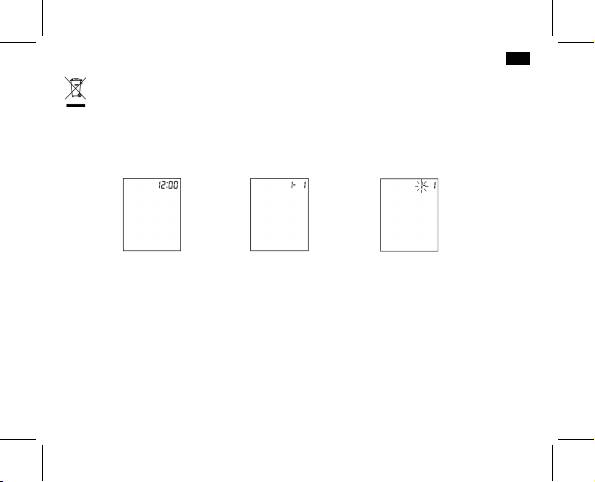
English
123
The monitor, the batteries and the cuff, must be disposed of according to local regulations at the
end of their usage.
2. CLOCK AND DATE ADJUSTMENT
a. Once you install the battery or turn off the monitor, it will enter Clock Mode, and LCD will display
time and date by turns. See Fig. 2 & 2-1.
Fig. 2 Fig. 2-1 Fig. 2-2
b. While the monitor is in Clock Mode, pressing the “START” button and the “MEM” button simul-
taneously; a beep is heard and the month will flash first. See Fig. 2-2. Press the button “START”
repeatedly; the day, the hour and the minute will flash in turn. While a number is flashing, press
the button “MEM” to increase the number. Hold the button “MEM” depressed, the number will
increase rapidly.
c. You can turn off the monitor by pressing the “START” button when the minutes are flashing,
then the time and the date are confirmed.
d. The monitor will turn off automatically after 1 minute of no operation; with the time and date
unchanged.
e. After replacing the batteries, you should set the time and the date again.
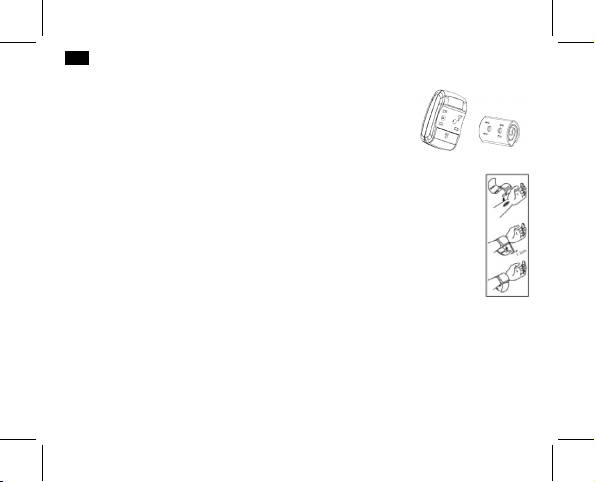
124
English
3. CONNECTING THE CUFF TO THE MONITOR
The cuff is attached to the monitor when it is packaged.
Should the cuff become unattached, align the two plugs
and four brackets of the cuff with the plug sockets and
bracket sockets of the monitor and press the cuff to the monitor until the
plugs and brackets are securely attached.
4. APPLYING THE CUFF
a. Place the cuff around a bare wrist 1-2 cm above the wrist joint on the palm side of
the wrist.
b. While seated, place the arm with the cuffed wrist in front of your body on a desk or
table with the palm up. If the cuff is correctly placed, you can read the LCD display.
c. The cuff must be neither too tight nor too loose.
Note:
1. Please refer to the cuff circumference range in “SPECIFICATIONS” to make sure that the ap-
propriate cuff is used.
2. Measuring on same wrist each time.
3. Do not move your arm, body, or the monitor during measurement.
4. Stay quiet, calm for 5 minutes before blood pressure measurement.
5. Please keep the cuff clean. If the cuff becomes dirty, remove it from the monitor and clear it by
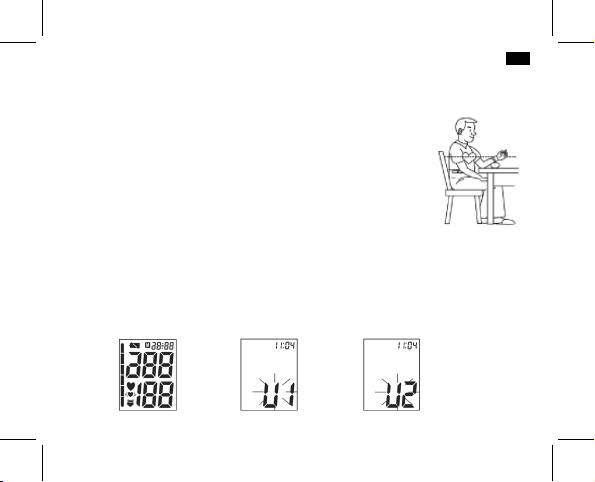
English
125
hand in a mild detergent, then rinse it thoroughly in cold water. Never dry the cuff in clothes
dryer or iron it. Clean the cuff after the usage of every 200 times is recommended.
5. BODY POSTURE DURING MEASUREMENT
Sitting Comfortably Measurement
a. Be seated with your feet flat on the floor, and don’t cross your legs.
b. Place palm upside in front of you on a flat surface such as a table.
c. The middle of the cuff should be at the level of the right atrium of the
heart.
6. TAKING YOUR BLOOD PRESSURE READING
a. After applying the cuff and with your body in a comfortable position, press the “START” button.
A beep is heard and all display characters are shown for self-test. See Fig. 6. Please contact the
service center if a segment is missing.
b. Then the current memory bank (U1 or U2) is flashing. See Fig. 6-1. Press the “MEM” button to
change to the other bank. See Fig. 6-2. Confirm your selection by pressing the “START” button.
The current bank will also be confirmed automatically after 5 seconds with no operation.
Fig. 6
Fig. 6-1 Fig. 6-2

126
English
c. After selecting the memory bank, the monitor starts to seek zero pressure. See Fig. 6-3.
d. The monitor inflates the cuff until sufficient pressure has built up for a measurement. Then the
monitor slowly releases air from the cuff and carries out the measurement. Finally the blood
pressure and pulse rate will be calculated and displayed on the LCD screen separately. Irregular
heartbeat symbol (if any) will blink. See Fig. 6-4 & 6-5. The result will be automatically stored in
the current memory bank.
Fig. 6-3
Fig. 6-4 Fig. 6-5
e. After measurement, the monitor will turn off automatically after 1 minute of no operation. You
can also press the “START” button to turn off the monitor manually.
f. During measurement, you can press the “START” button to turn off the monitor manually.
Note:
Please consult a health care professional for interpretation of pressure measurements.
7. DISPLAYING STORED RESULTS
a. After the measuring, you can review the measurements in the current memory bank by pressing
the button “MEM”. Now the LCD displays the amount of the results in the current bank. See
Fig. 7.

English
127
Fig. 7
Fig. 7-1 Fig. 7-2
b. You can also press the “MEM” button in Clock Mode to display the stored results. The current
memory bank will flash and the amount of results in this bank will be displayed. See Fig. 7-1.
Press the “START” button to change to the other bank. See Fig. 7-2. Confirm your selection
by pressing the “MEM” button. The current bank will also be confirmed automatically after
5 seconds with no operation.
c. After selecting the memory bank, the LCD will display the average value of the last three results
in this bank. See Fig. 7-3 & 7-4. If no results are stored, the LCD will show dashes as shown in
Fig. 7-5.
Fig. 7-3 Fig. 7-4
Fig. 7-5
d. When the average is displayed and you press the “MEM” button, the most recent result will be
displayed. See Fig. 7-6. Then the blood pressure and the pulse rate will be shown individually.
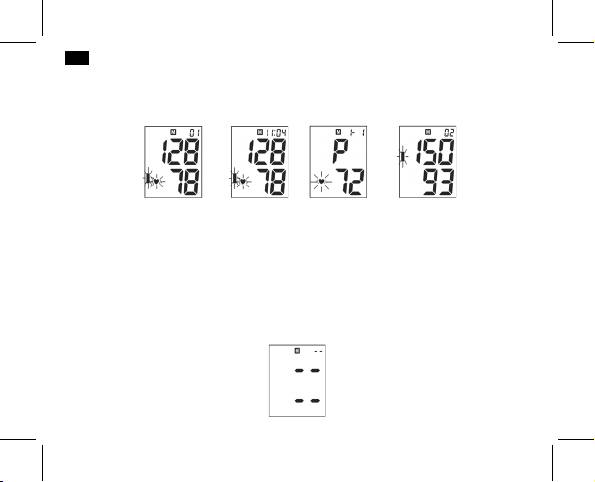
128
English
Possibly the irregular heartbeat symbol may flash. See Fig. 7-7 & 7-8. Press the “MEM” button
again to display the next result. See Fig. 7-9. In this way, repeatedly pressing the “MEM” button
displays the respective results measured previously.
Fig. 7-6 Fig. 7-7
Fig. 7-8 Fig. 7-9
e. When displaying the stored results, the monitor will turn off automatically after 1 minute of no
operation. You can also press the “START” button to turn off the monitor manually.
8. DELETING MEASUREMENTS FROM THE MEMORY
When any result (except average reading of the last three results) is displayed and you keeping press-
ing the “MEM” button for three seconds, all results in the current memory bank will be deleted after
three “beeps”. The LCD will show Fig. 8; pressing the “MEM” or the “START” button will turn off the
monitor.
Fig. 8

English
129
9. ASSESSING HIGH BLOOD PRESSURE FOR ADULTS
The following guidelines for assessing high blood pressure (without regard to age or gender) have
been established by the World Health Organization (WHO). Please note that other factors (e.g.
diabetes, obesity, smoking, etc.) also must be taken into consideration. Consult with your physician
for accurate assessment, and never change your treatment by yourself.
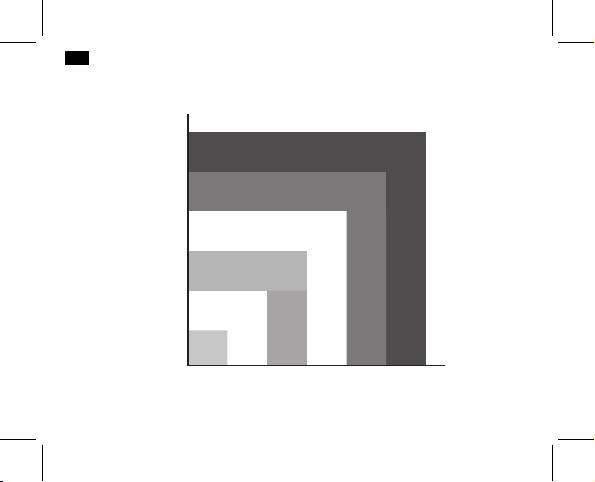
130
English
Blood pressure classification for adults
Systolic (mm HG)
Severe hypertension (level 3)
180
Hypertension (level 2)
160
Light hypertension (level 1)
140
Slightly increased blood
pressure
130
Normal
120
80 85 90 100 110
Diastolic (mm HG)
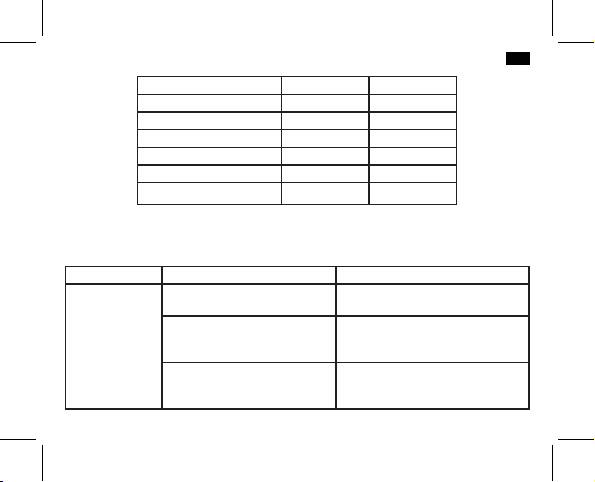
English
131
Blood pressure classification SYS (mm HG) DIA (mm HG)
Optimal <120 <80
Normal 120 - 129 80 - 84
high - normal 130 - 139 85 – 89
Hypertension level 1 140 - 159 90 – 99
Hypertension level 2 160 - 179 100 – 109
Hypertension level 3 ≥180 ≥110
Definition and classification of the blood pressure values according to WHO/ISH
10. TROUBLESHOOTING (1)
PROBLEM POSSIBLE CAUSE SOLUTION
The cuff position was not correct or it
Apply the cuff correctly and try again
was not properly tightened
Review the section “BODY POSTURE
Body posture was not correct during
LCD Display shows
DURING MEASUREMENT” of the instruc-
testing
abnormal result
tions and try again.
Speaking, arm or body movement,
Re-test when calm and without speaking
angry, excited or nervous during test-
or moving during the test
ing
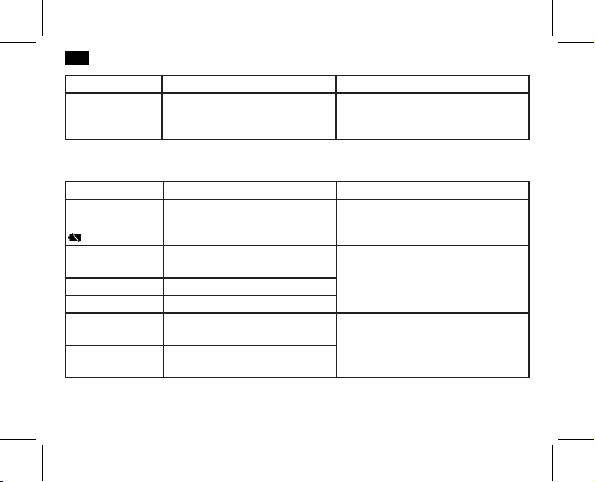
132
English
PROBLEM POSSIBLE CAUSE SOLUTION
It is inappropriate for people with serious
LCD Display shows
Irregular heartbeat (arrhythmia)
arrhythmia to use this Electronic Sphygmo-
abnormal result
manometer.
11. TROUBLESHOOTING (2)
PROBLEM POSSIBLE CAUSE SOLUTION
LCD shows the sym-
bol for a low battery
Low battery Change the batteries
Pressure system is unstable before
LCD shows “Er 0”
measurement
Don’t move and try again.
LCD shows “Er 1” Fail to detect systolic pressure
LCD shows “Er 2” Fail to detect diastolic pressure
Pneumatic system blocked or cuff is
LCD shows “Er 3”
too tight during inflation
Apply the cuff correctly and try again
Pneumatic system leakage or cuff is
LCD shows “Er 4”
too loose during inflation
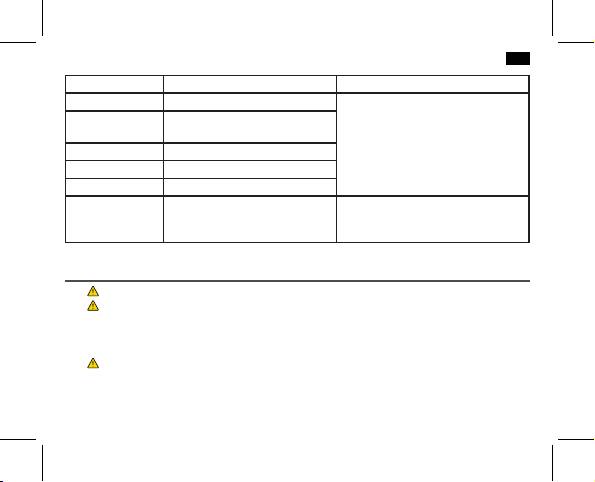
English
133
PROBLEM POSSIBLE CAUSE SOLUTION
LCD shows “Er 5” Cuff pressure above 300 mm Hg
More than 3 minutes with cuff pres-
LCD shows “Er 6”
Measure again after five minutes. If the
sure above 15 mm Hg
monitor is still abnormal, please contact
LCD shows “Er 7” EEPROM accessing error
the local distributor or the factory.
LCD shows “Er 8” Device parameter checking error
LCD shows “Er A” Pressure sensor parameter error
No response when
Incorrect operation or strong electro-
Take out batteries for five minutes, and
you press a button
magnetic interference.
then reinstall all batteries.
or load batteries.
MAINTENANCE
1. Do not drop this monitor nor subject it to strong impacts.
2. Avoid high temperatures and direct sunlight. Do not immerse the monitor in water as this will
result in damage to the monitor.
3. If this monitor was stored at a temperature near the freezing point, allow it to come to room tempera-
ture before use.
4. Do not attempt to disassemble this monitor.
5. If you do not use the monitor for a long time, please remove the batteries.
6. It is recommended the performance should be checked every 2 years or after repair. Please contact
the service center.
Оглавление
- BMG 5610
- Inhalt
- Übersicht der Bedienelemente
- Deutsch
- Deutsch
- Deutsch
- Deutsch
- Deutsch
- Deutsch
- Deutsch
- Deutsch
- Deutsch
- Deutsch
- Nederlands
- Nederlands
- Nederlands
- Nederlands
- Nederlands
- Nederlands
- Nederlands
- Nederlands
- Nederlands
- Français
- Français
- Français
- Français
- Français
- Français
- Français
- Français
- Français
- Español
- Español
- Español
- Español
- Español
- Español
- Español
- Español
- Español
- Italiano
- Italiano
- Italiano
- Italiano
- Italiano
- Italiano
- Italiano
- Italiano
- Italiano
- English
- English
- English
- English
- English
- English
- English
- English
- English
- Język polski
- Język polski
- Język polski
- Język polski
- Język polski
- Język polski
- Język polski
- Język polski
- Język polski
- Magyarul
- Magyarul
- Magyarul
- Magyarul
- Magyarul
- Magyarul
- Magyarul
- Magyarul
- Magyarul
- Українська
- Українська
- Українська
- Українська
- Українська
- Українська
- Українська
- Українська
- Українська
- Русский
- Русский
- Русский
- Русский
- Русский
- Русский
- Русский
- Русский
- Русский
-
-
-
-
-
-
-
-
-

